An interesting interview in Christ & Welt, a weekly supplement to Die Zeit in Germany, with Archbishop Georg Gänswein yesterday. It sheds some interesting lights on recent developments in the Vatican, such as Pope Francis’ Christmas talk to the Curia, the Pope’s relationship with the media, the Synod and also retired Pope Benedict XVI and some personal touches. Worth a read:
C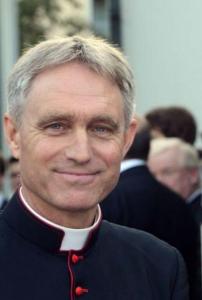 &W: At Christmas Pope Francis caused some furore with his talk about fifteen diseases of the Roman Curia. You were seated directly next to the Pope. At what point did you stop counting?
&W: At Christmas Pope Francis caused some furore with his talk about fifteen diseases of the Roman Curia. You were seated directly next to the Pope. At what point did you stop counting?
Georg Gänswein: As Prefect of the Papal Household I sat, as ever on such occasions, at the Pope’s right. And as ever I had a copy of the talk in my briefcase, but I hadn’t had the time to read it beforehand. When the list of diseases began I thought to myself, “Now it’s going to be interesting”, and it became ever more interesting. I counted until the ninth disease…
What went through your head?
Normally the Pope uses the Christmas reception for the Curia to look back on the past year and look ahead to the coming one. It was different this time. Pope Francis preferred to hold up a mirror of conscience to the cardinals and bishops, among them a few who were retired…
Did you feel like it appealed to you?
Of course I asked myself, “Who does this concern? What disease affects you? What needs to be corrected?” At one point I had to think of my many moving boxes.
Do you mean the anecdote about the moving of a Jesuit with countless possessions? Francis had said that moving was a sign of the “disease of hoarding”.
Exactly. Since leaving the Apostolic Palace after the retirement of Pope Benedict in February of 2013 more than a few of my things are still in boxes in a storeroom. But I can’t see a sign of disease in that.
What did Pope Francis intend with this act of flagellation? It could be demotivating.
That is a question that many of my colleagues also asked. Pope Francis has been in office for almost two years now and knows the Curia pretty well. He obviously thought it necessary to speak clearly and to cause an examination of conscience.
What were the reactions?
It was a treat for the media, of course. During the talk I could already see the headlines: Pope castigates Curia prelates; Pope reads his coworkers the law! Sadly, outwardly it gave the impression that there was a rift between the Pope and the Curia. That impression is deceiving, and does not coincide with reality. But the address drowned that out.
Was the talk criticised internally?
The reactions ranged from surprise to shock and incomprehension.
Perhaps with Francis, the Curia needs to adjust to permanent spiritual exercises?
It has long been adjusted to that. Pope Francis makes no secret of his religious formation. He is a Jesuit, shaped through and through by the spirituality of the founder of his order, Saint Ignatius of Loyola.
What are your thoughts about Francis, two years after his election?
Pope Francis is a man who has made it clear from the outset that he deals differently with things that he sees differently. That is true for his choice of living, the car he drives, the entire process of audiences in general and especially for protocol. One could think that he was getting used to things in the beginning and wanted a significant degree of flexibility. By now it has become standard. The Holy Father is a man of extraordinary creativity and Latin American zest.
Many still ask where we are going?
If you listen attentively to the words of the Pope, you will hear a clear message in them. Nevertheless, the question continuously arises of where Francis wants to lead the Church, what is his goal?
One year ago you said, “We are still waiting for substantial standards.” Can these now be seen?
Yes, much more clearly than a year ago. Consider the Apostolic Letter Evangelii gaudium. In it he has presented a compass for his pontificate. In addition he has published important documents and given major addresses over the course of the year, such as in Strasbourg for the European Parliament and the Council of Europe. Contours have become clearly visible and clear priorities were set.
Such as?
The most important priority is mission, evangelisation. This aspect is like a red thread. No internal navelgazing, no self-reference, but sharing the Gospel with the world. That is the motto.
Do you understand Francis George, the retired archbishop of Chicago, who criticised the fact that the words of the Pope are often ambivalent?
There have indeed been cases in which the Vatican spokesman had to clarify matters after specific publications. Corrections are necessary when certain statements lead to misunderstandings which can be collected from certain sites.
Does Francis have a better grip of the media than his predecessor Benedict?
Francis deals with the media offensively. He used them intensively and directly.
Also more skilful?
Yes, he uses them very skilfully.
Who are actually his closest advisors?
This questions always and consistently goes around. I don’t know.
With the Synods on the pastoral care for families this past and the coming autumn, Francis created a focal point. Especially the question of allowing divorced and remarried faithful access to the sacraments causes much disagreement. Some also have the impression that Francis is more concerned with pastoral care than with doctrine…
I do not share that impression. It creates an artificial opposition which does not exist. The Pope is the first guarantor and keeper of the doctrine of the Church and at the same the first shepherd, the first pastor. Doctrine and pastoral care are not in opposition, they are like twins.
Do the current and the retired Pope take opposite views in the debate about divorced and remarried Catholics?
I know of no doctrinal statements from Pope Francis which are contrary to the statements of his predecessor. That would be absurd too. It is one thing to emphasise the pastoral efforts more clearly because the situation requires it. It is something else entirely to make a change in teaching. I can only act pastorally sensitive, consistent and conscientious when I do so on the basis of full Catholic teaching. The substance of the sacraments is not left to the discretion of pastors, but has been given to the Church by the Lord. That is also and especially true for the sacrament of marriage.
Was there a visit of some cardinals to Benedict during the Synod, with the request that he intervene to rescue the dogma?
There has not been such a visit to Pope Benedict. A supposed intervention by the Pope emeritus is pure invention.
How does Benedict respond to the attempts by traditionalist circles to recognise him as an antipope?
It was not traditionalist circles who attempted that, but representatives of the theological profession and some journalists. Speaking of an antipope is simply stupid, and also irresponsible. That goes in the direction of theological arson.
Recently there was excitement surrounding a contribution in the recently published fourth volume of the Collected Works of Joseph Ratzinger. The author changed some conclusions to the topic of the divorced and remarried in a stricter sense. Does Benedict want to involve himself with this in the Synod debate?
Not at all. The revision of said article from 1972 was completed and sent to the publisher long before the Synod. It must be remembered that every author has the right to make changes in his writings. Every informed person knows that Pope Benedict has not shared the conclusions of said contribution since 1981, which is more than 30 years! As Prefect of the Congregation for the Doctrine of the Faith he has expressed this clearly in various comments.
The timing of the publication of the new edition to coincide with the Synod was then anything but happy…
The fourth volume of the Collected Works, in which the article is printed, was supposed to be published in 2013. The publication was delayed for various reasons and happened only in 2014. That a Synod on the topic of the family would take place at that time, was absolutely unforeseen when the planning of the publication of the separate volumes was made.
Upon his retirement, Benedict XVI said that he would be living “hidden from the world”. He continues to make appearances, however. Why?
When he is present at important Church events, it is because he is personally invited by Pope Francis, for example when he took part in the consistory of last February, the canonisation of John Paul II and John XXIII in April and also the beatification of Paul VI in October. He has also written a greeting for the inauguration of the Auditorium Maximum of the Pontifical Urbaniana University in Rome, which was named after him. Pope Benedict was invited for that, but did not accept that invitation.
In the greeting, which you read out on his behalf at the time, he however makes clear theological statements. “The elimination of truth is lethal for the faith,” he wrote.
The greeting was an impressive contribution to the topic of “Truth and Mission”. You could hear a pin drop, it was so quiet during the reading in the crowded auditorium. Content-wise, it was a theological classic. Pope Francis, who had received the text from Benedict beforehand, was much impressed and had thanked him for it.
Does Benedict sometimes speak about his retirement? Is he relieved?
He is at peace with himself and convinced that the decision was right and necessary. It was a decision of conscience that was well prayed and suffered over, and in that man stands alone before God.
You struggled with Benedict’s historical retirement in February of 2013. How do you look back on this step now?
It is true that the decision was difficult for me. It was not easy to accept it internally. I struggled to cope. The fight is now long since over.
You swore to be loyal to Benedict to the death. Does that also mean that you’ll remain at his side, and also in the Vatican?
On the day of his election as Pope I promised to help him in vita et in morte. Of course I did not take a retirement into account at that time. But the promise is still true and remains valid.
Bishops should be shepherds. As archbishop in the Roman Curia, do you sometimes feel like a shepherd without a flock?
Yes, sometimes. But I am getting more and more invitations for confirmations, anniversary Masses and other celebrations. Initially I responded somewhat defensive to those and accepted only a few. But that has changed lately. Direct contact with the faithful is very important. That is why I accept pastoral duties whenever it is possible and compatible with my other obligations. That is both good and necessary. And it is also the best medication against one of the diseases of the Curia mentioned by Pope Francis: the danger of becoming a bureaucrat.
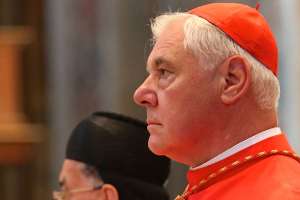 Suddenly, an increase in rumours that Cardinal Gerhard Müller is to be let go as Prefect of the Congregation for the Doctrine of the Faith appeared tonight. Should the rumours prove true, what can we say about it now?
Suddenly, an increase in rumours that Cardinal Gerhard Müller is to be let go as Prefect of the Congregation for the Doctrine of the Faith appeared tonight. Should the rumours prove true, what can we say about it now? Bishop Jan Liesen responds to the news of the passing of Bishop Hubertus Cornelis Antonius Ernst, emeritus bishop of Breda, six weeks after celebrating his 100th birthday. The most senior of the Dutch bishops passed away late in the evening on Friday 19 May.
Bishop Jan Liesen responds to the news of the passing of Bishop Hubertus Cornelis Antonius Ernst, emeritus bishop of Breda, six weeks after celebrating his 100th birthday. The most senior of the Dutch bishops passed away late in the evening on Friday 19 May.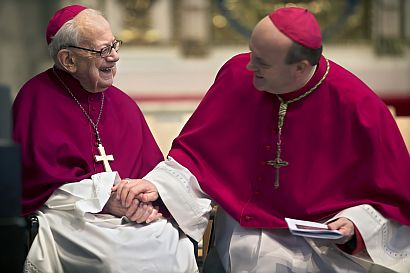 “Into very old age Bishop Huub Ernst was vital and concerned with his diocese, the Church province and society as a whole. He was consecrated as a bishop almost fifty years ago. Recently, we were able to congratulate him with his 100th birthday. Bishop Ernst was our older brother in the office of bishop, possessing a great heart for charity and the work of peace.”
“Into very old age Bishop Huub Ernst was vital and concerned with his diocese, the Church province and society as a whole. He was consecrated as a bishop almost fifty years ago. Recently, we were able to congratulate him with his 100th birthday. Bishop Ernst was our older brother in the office of bishop, possessing a great heart for charity and the work of peace.”
 &W: At Christmas Pope Francis caused some furore with his talk about fifteen diseases of the Roman Curia. You were seated directly next to the Pope. At what point did you stop counting?
&W: At Christmas Pope Francis caused some furore with his talk about fifteen diseases of the Roman Curia. You were seated directly next to the Pope. At what point did you stop counting? “The Pope and the Holy Spirit: do they get along? It seem a superfluous question. But much ink has been spent and battle has been done, but in and outside the Church, about that topic. For some the Holy Spirit is invisible where the Pope is. For others the Pope is invisible where the Holy Spirit is. Institute and charisma, durability and renewal, shepherding and prophecy: they are so easily put in opposition to one another. Yet the story of Pentecost begins in the house where the Apostles are. They are among the first to receive the Spirit for the mission that the Lord has entrusted to them.
“The Pope and the Holy Spirit: do they get along? It seem a superfluous question. But much ink has been spent and battle has been done, but in and outside the Church, about that topic. For some the Holy Spirit is invisible where the Pope is. For others the Pope is invisible where the Holy Spirit is. Institute and charisma, durability and renewal, shepherding and prophecy: they are so easily put in opposition to one another. Yet the story of Pentecost begins in the house where the Apostles are. They are among the first to receive the Spirit for the mission that the Lord has entrusted to them.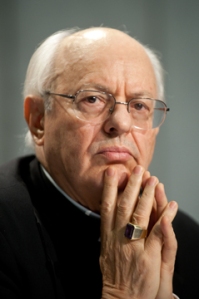 “Regarding the possibility for the synod of bishops of changing the doctrine of the Church, I underscore that the First Vatican Council’s document Dei Filius affirmed that “understanding of its sacred dogmas must be perpetually retained, which Holy Mother Church has once declared; and there must never be recession from that meaning under the specious name of a deeper understanding.”
“Regarding the possibility for the synod of bishops of changing the doctrine of the Church, I underscore that the First Vatican Council’s document Dei Filius affirmed that “understanding of its sacred dogmas must be perpetually retained, which Holy Mother Church has once declared; and there must never be recession from that meaning under the specious name of a deeper understanding.”






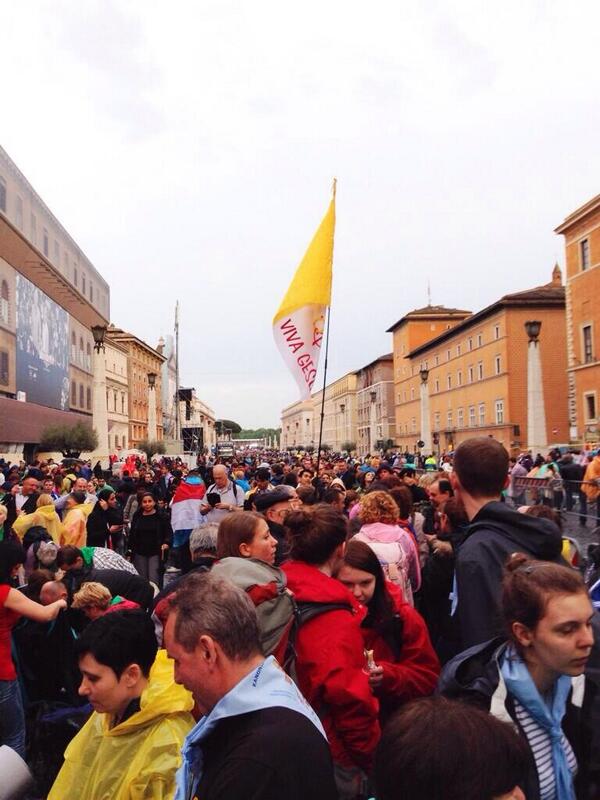




 In the run-up to the canonisation of Popes John XXIII and John Paul II, Kath.net publishes the first part of
In the run-up to the canonisation of Popes John XXIII and John Paul II, Kath.net publishes the first part of 

